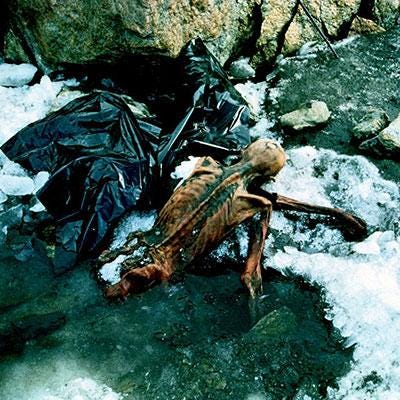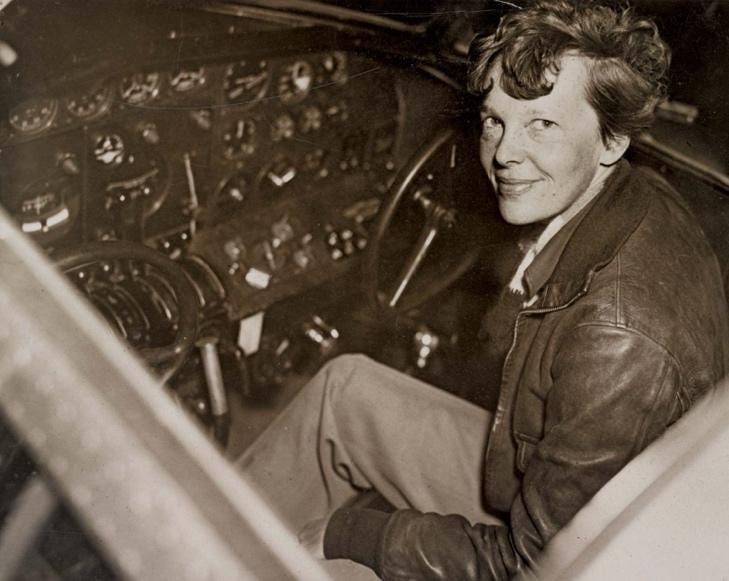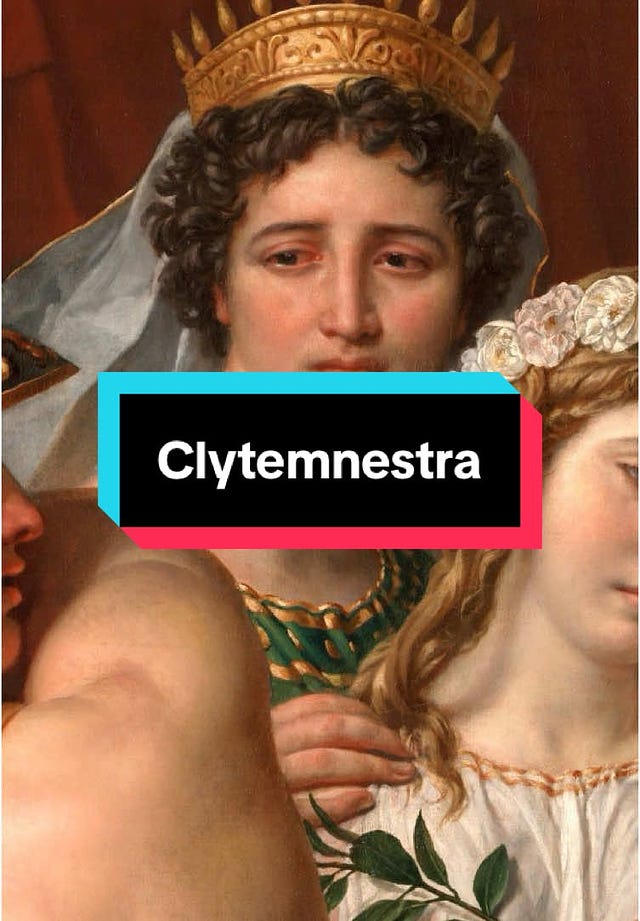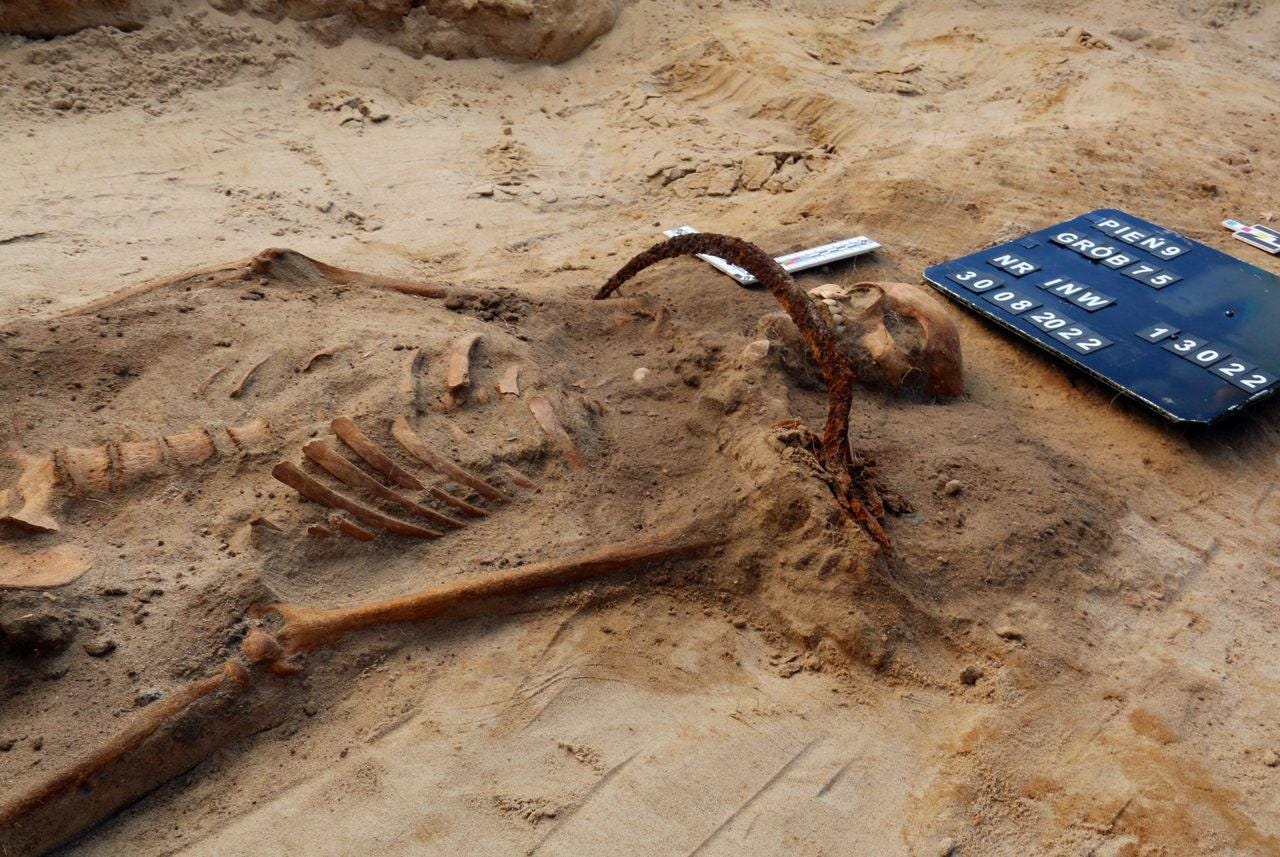What do Ötzi the Iceman, Amelia Earhart, and Polish vampires all have in common?
An extra special//extra spooky guest post just in time for Halloween 👻
Before we get into this week’s Halloween-themed guest post (it’s a collection of archaeological murder mysteries 🩸 and it’s an absolute riot), I want to quickly say hi, happy Tuesday, merry spooky season, etc. I also want to point you in the direction of three things.
an event
I’m hosting a symposium/salon moment this Saturday (the 2nd of November) in London. The theme is garden of earthly delights 🍏 and you can find all the info here:
www.eventbrite.com/e/garden-of-earthly-delights-tickets
and/or over on Instagram if you follow me there.
There’s going to be live music, poetry readings, ridiculous food, themed cocktails, and MORE so if this is up your alley please come through! I’ve got a vintage confession box, some sort of ancient ceremonial wood that we’re supposed to burn, and literally HUNDREDS of apples. Also if the ticket price is a bit toppy but you want to come just shoot me a message, I’m sure we can figure out some sort of Substack discount 🤫
a book
My reading brain is spread a bit too thin at the moment and I do NOT like it (I’m normally strictly monogamous when it comes to reading and this foray into literary polyamory is NOT going well). The book I am focussing on (and enjoying the most) is Daisy Dunn’s The Missing Thread: A New History of the Ancient World Through the Women Who Shaped It.
I’m not going to rave or squeal at length—I don’t want to delay your reading about Ötzi’s tattoos or Slavic vampire hunters more than is STRICTLY necessary—but here are Dunn’s words on Sappho to give you a taste:
“‘An army of horsemen, some say, or infantry, / Or a fleet of ships is the most beautiful / Thing on black earth, / But I say it's what one loves.’ There is such confidence in Sappho's poetic voice. Reading her words can make you feel like you are entering the space between two people caught in the middle of something. They have been having a row, perhaps, or they are trying to say goodbye before one of them leaves on a voyage from which the other fears they will never return. The air between them is yet to clear, but somehow Sappho has swept it up, carried it away to somewhere even more private to scrutinise with what transpires to be the very opposite of an objective eye. Even - especially - when she herself is one of the two people involved and has fair claim to be the injured party.”1
and a tiktok
 Tiktok failed to load.
Tiktok failed to load.Enable 3rd party cookies or use another browser
About 15 seconds of a raging, grieving Clytemnestra set to an audio that I think is Charlize Theron screaming in one of those Snow White films(??). Just incredible.
That’s all from me this week, read on for the main event.
xxx
**TW: this newsletter has photographs of human remains and those who have died, and mentions of blood. These images are publicly available.**
Hello fiends,
The spooky season is well and truly upon us, and, as your vampiric obsessed bisexual, I am here to deliver some spooky case studies of murder, mystery, and, of course, divine blood demons (no shame here, you do you).
Put on your fang grilz, grab your magnifying glasses, and strap (on) in for the ride.
THE MURDER OF ÖTZI THE ICE MAN
In 1991, hikers along the Austrian-Italian border stumbled upon a body of a man face down in the melting snow. This launched an investigation (!!) to figure out who the man was (that was nicknamed Ötzi), and how he had died / ended up in the snow.

Thank God there were items at the scene (‘prestigious’ weapons, tools etc), meaning it might not be a recent murder (even though he was incredibly well preserved and fleshy), but a body from the Copper Age (3300 BCE through radiocarbon dating – fucking wild).
Further analysis on the remains revealed (so many things!!) that he could have been a Chief or copper smelter, about 160cm tall, roughly between 25-45 years old (this is not super accurate so don’t even, I can rant for years), had a meal (ibex meat) less than 2 hours before his death, and that he was lactose intolerant (??).
Extremely important side note: he is so fucking well preserved that we can see skin markings (ie. possibly 61 tattoos – This is debated, but I believe they are tattoos, and I want them on my body. Hello potential demon curse, we are here for it).

Later, it was found that an arrow head was embedded into Ötzi’s left shoulder blade (ouch), he had a hand dagger injury (this can indicate defensive wounds in modern forensic investigations), and possibly a blow to the head (poor guy). One theory suggests that the arrow head led to him bleeding out, and dying where he fell. As we know it, his murderer was never brought to justice (If we project our justice system onto the Copper age – which is a gross concept but fun to think about).
I would definitely recommend reading up, there is so much information out there – but this then brings into question ‘Do we have the right to analyse a body this much? He is still a human..’
Research continues on the oldest naturally occurring European mummy, our Ötzi, and you can (maybe) go visit him at the South Tyrol Museum of Archaeology in Bolzano, Italy.
We will avenge you Ötzi.
THE MYSTERY (?) OF AMELIA EARHART
On 1 June 1937, record-breaking female aviator Amelia Earhart (and her navigator) flew out of Miami to become the first woman to fly around the world.

Can we just for a second take a minute to acknowledge that she was not the *only* record-breaking female aviator of the time, there was Bessie Coleman, Amy Johnson, Jean Batten, Beryl Markham, and not to mention ‘The Ninety-Nines’. BUT because Amelia had a “boy-ish charm” to her, she was “more easily accepted”, acknowledged, and recognised by society at the time. There is a lot of discord about this, especially for the 1920s/30s treatment of women (those who adapted to the restraints of misogyny, or those who revolted against it).
On 2 July, they left New Guinea with US ships (with all of their lights on) lighting the way through the pacific island to help guide Amelia to Howland Island and home (so cute my heart hurts). While the weather was reported to be clear, the conditions changed, radio transmissions were irregular and unreliable, and the inaccurate maps proved navigation difficult.
07:45 am July 3 from Amelia : “We must be on you, but we cannot see you. Fuel is running low. Been unable to reach you by radio. We are flying at 1,000 feet.”
The plane did not seem to receive the ship’s messages.
Amelia’s last transmission at 08:45am on 3 July was the last contact.
From Amelia : “We are running north and south.”
A search and rescue attempt immediately commenced, and continued until the 19 July (16 days, and $4 million later – HUGE moolah for the 1930s).
In 1940, bones of an individual and castaway artefacts were found ‘under a ren tree’ on Nikumaroro Island (640 kms south west of Howland Island). These bones were analysed by Dr. David Hoodless of the Central Medical School for the Colony of Fiji, and he determined that they were the bones of a man.
During WWII these bones and artefacts were lost. How convenient.
However, the records of the bone measurements were found in the archives in 1997, and subsequently used to reanalyse the case in 1998 (suggesting it was actually Amelia Earhart), which was disputed in 2015, then re-suggested in 2017, then reanalysed and suggested again in 2018.
Oh the drama!
Seeing that we are scientists after all (unfortunately), the major criticism was that ONLY the measurements of the bones were analysed (with improved methods) and not the actual bones themselves. Because how much do we really trust others, who are not forensic experts, to measure things correctly?
INTERESTINGLY ENOUGH, somehow, magically, fragments of those exact bones (but is it really??) were found at the Te Umwanibong Museum and Cultural Centre on Tarawa, Kirbati. These bones were analysed and confirmed as the original bones found from the 1940s (interesting hey), and then were tested for DNA in 2019 against Amelia’s only living relative, her niece. No results were revealed in 2019.
In 2021, another expert revealed that the DNA test results were negative! And that the bones did not belong to Amelia.
Which A) could make sense but could be misconstrued, because DNA matches are based on quality samples (which is hard to determine for this case, fragments reduce the quality and increase the possibility for contamination) and statistics (and a niece is not a direct biological link, but once removed). Maybe they cannot confirm with certainty it is her, and that does not imply it is not her. It’s all about how you word things.. Maybe she was not a match against the statistical threshold they tested against. Who knows?
B) How on earth does someone else know the results AND those who did the analysis have not reported the results? Sus.
Who was under the ren tree? Where did Amelia and her navigator go?
To this day, it is still a mystery, and the search continues..
And finally, we reach…
THE VAMPIRES OF POLAND
The highly anticipated, and exquisitely gothic portion of today’s spooky season read.
Coming from misty Slavic / Eastern European origins (my personal favourite vibe) in the medieval period, vampires were very different. While the concept of a sexy, velvet clad, blood drinking demon is an adapted modern vision (pov: the dream), the origins are more along the lines of non-corporeal beings rising from the dead and spreading disease and terror (and this was prior to the creation of the English word vampire).
Blood drinking was added later as a pseudo-scientific element to ‘explain’ the spread of disease and giving of ‘life’.
Look, it’s a start, it’s still early days for science – I could do a WHOLE tangent on science/the dead here but I won’t.
Now, to kill a vampire, as you can imagine, after a DEEP dive, there are a bajillion different ways. It’s not as straightforward as a stake to the heart (as we have been misled to believe – which I think is to the current vampires’ advantage).
We do know that the living used to open graves to add anti-vampire artefacts (if not already done at burial) to prevent the ‘vampire’ rising from the dead and returning to the living. No one has the time to wait for them to rise! We can’t all be Buffy and skip out on our dates.
Which has now led us to find a string of burials in Poland dating from medieval to the early modern period that has given rise to the question of vampires in Poland. But we know that during the rise of Catholic dogma during the time period, Polish villages returned to their Slavic beliefs.
And back to their vampire hunting ways, if we believe.
In 2022 in the village of Pień in Poland, a skeleton dating to the 17th century was found with a sickle placed around its neck (to sever the neck if they got up), a padlock around the big toe of the left foot (to make it impossible to return to the living), and a copper/copper alloy object (possibly a coin) in the mouth (to ward off evil). The body was of an approximately 17-21 year old (more accurate as some of the bones were still growing) woman, buried with a (possibly) silk bonnet inside a coffin. The care when burying her is surprising when paired with anti-vampiric practices – interesting and suspicious.
At the same site in 2023, a child was found face down with a padlock near its feet, which was very typical for anti-vampiric burials to prevent them from coming back.
In a 17th century cemetery in Drawsko, Poland, six individuals in the cemetery were found with sickles and/or a stone on the throat, and a coin either in their mouth or around the head.
Taking the coin ‘in or around the mouth’ theory further, there is suspicion that to kill the vampire you had to place something un-eatable in their mouth. Other burials have found bricks shoved into the mouth of the ‘vampire’.
Very similar burials have been found throughout Poland and Europe. There are even records of a town in the 17th century being ravaged by a vampire who drank human blood. He was then decapitated – one of the popular ways to kill a vampire, and other anti-vampire burials have reported decapitation.
Now, we could chalk this up to the fact that vampires were believed to spread diseases so to have an increase of ‘vampire’ burials in the 17th century when plagues and epidemics ravaged eastern Europe sorta makes sense. And maybe these individuals were just sick.
But I raise you this counter offer, maybe the vampire hunters were just really good at their job and these ‘vampires’ stayed dead.
Who knows.
And that brings me to the end of this spooky feature for Cosi. Have a wonderful scary season with whatever spiritual, cultural or religious rituals you subscribe to, and if not, enjoy the horror vibes.
Kristy A Winter is a Forensic Anthropologist with the hiccups. They have a Masters in and are Professionally Certified as a Forensic Anthropologist (III), and slogging through their final 4 months of a PhD, in (as you guessed it) 'Documentation of missing and unidentified persons for identifications' (lol). Kristy loves talking, reading and working everything death related. She is currently selling death/bone related merch for her leadership course in Antarctica - but right now works as a Forensic Specialist in the humanitarian and human rights sector.
Dunn, 2024, 3.







This one hits on so many things I love! Years ago I went to a Sherlock Holmes themed event and the speaker was the head of the BKA Serial Crimes Unit (essentially German version of criminal minds). He conducted a forensic investigation to “find” Ötzi’s killer. Honestly one of my favorite nights